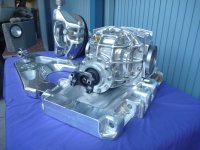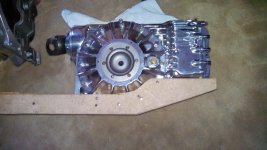Isdtbower
In for Tech
There are some needs for independent suspension diffs. Short CV-CV distance for longer Half shafts. And diffs that do not hang down into the ground.
The most used is the 9" case. From the CV center to the bottom is 5". From CV-CV flange to flange series 30 is about 14" with the stock casse and about 13" when you cut off one side. Inboard rotors should nt be greater than the mentioned 10" for ground clearance.
The Aussie case is huge and heavy and is about 7-8" from CV center to the bottom. I believe they can build CV to CV for long arms but the ground clearance kind of negates some of that ability. Because of the mass you could run 15" inboard rotors, and some have.
I settled on a 12" quick change. But the CV to bottom is 7". The Flange to flange CV's 935 is 7". It might be possible to run inboards, but my 13" brakes will fit inside a deep dish 17" forged wheel.
Weismann produced an Offset Pinion independent diff that could run CV to CV back to back, But was also 7" CV 935 to bottom. The real feature was the offset pinion to get a driveshaft around a front engine pan. Used mostly in Pro Four. Cool but lots of maintenance and $30k budget.
These two considerations are just the start of whether a diff is good for you. (In my case, I considered cv-cv distance critical. I designed to 24" articulation maxing the CV's to 25* IRS. Then checked ground clearance and lost 6+ inches in stuff. (Don't let chassis pictures on jacks fool you. It didn't me but I had no clue it was that much loss. IFS front=9". IRS rear=Quick Change.
FAst 4400 cars use the hell out of brakes. They run red to white hot when on the gas. A driver will usually trail brake to use the anti's to settle the car at speed. The new active shocks can help that problem, and selectable in the cab, or in the GPS. Most car maintenance seems to be hittiing stuff (stopping the drivetrain) and from braking loads.
The most used is the 9" case. From the CV center to the bottom is 5". From CV-CV flange to flange series 30 is about 14" with the stock casse and about 13" when you cut off one side. Inboard rotors should nt be greater than the mentioned 10" for ground clearance.
The Aussie case is huge and heavy and is about 7-8" from CV center to the bottom. I believe they can build CV to CV for long arms but the ground clearance kind of negates some of that ability. Because of the mass you could run 15" inboard rotors, and some have.
I settled on a 12" quick change. But the CV to bottom is 7". The Flange to flange CV's 935 is 7". It might be possible to run inboards, but my 13" brakes will fit inside a deep dish 17" forged wheel.
Weismann produced an Offset Pinion independent diff that could run CV to CV back to back, But was also 7" CV 935 to bottom. The real feature was the offset pinion to get a driveshaft around a front engine pan. Used mostly in Pro Four. Cool but lots of maintenance and $30k budget.
These two considerations are just the start of whether a diff is good for you. (In my case, I considered cv-cv distance critical. I designed to 24" articulation maxing the CV's to 25* IRS. Then checked ground clearance and lost 6+ inches in stuff. (Don't let chassis pictures on jacks fool you. It didn't me but I had no clue it was that much loss. IFS front=9". IRS rear=Quick Change.
FAst 4400 cars use the hell out of brakes. They run red to white hot when on the gas. A driver will usually trail brake to use the anti's to settle the car at speed. The new active shocks can help that problem, and selectable in the cab, or in the GPS. Most car maintenance seems to be hittiing stuff (stopping the drivetrain) and from braking loads.
Attachments
Last edited:




